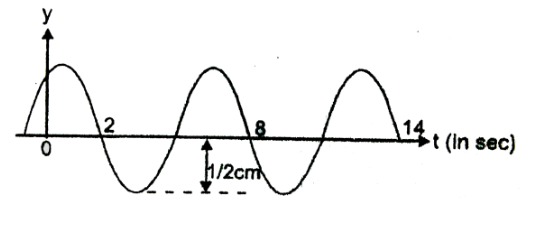
The sketch in the figure shows the displacement time curve of a sinusoidal wave at
(A)
(B)
(C)
(D)


Answer
441.3k+ views
Hint :Use the general equation of a sinusoidal wave and find the different parameters of the wave. The general equation of a sinusoidal wave propagating along positive X-direction is given by,
Complete Step By Step Answer:
We know that the equation of a sinusoidal wave propagating along positive X- direction is given by,
From the figure we can see that at
Now, we know that the frequency of a wave is the total number of complete oscillation in one second.
Hence, frequency of the wave will be,
So, the angular frequency of the wave will be,
Putting the values we get,
Now, From the figure we can see that the amplitude of the wave is ,
Now we know that the propagation constant of the wave is related to the wavelength of the wave as,
We have given here that the velocity of the wave is,
Putting the values we get,
Hence propagation constant will be,
So, putting these values in the sinusoidal wave equation we get the wave equation as,
Since, there is insufficient data to find the initial phase of the wave we have to check the available options.
Now, putting,
we get,
Or,
So, putting
We get,
Or,
From observation of the graph we can see that the value of
So, equation of the wave will be,
So, Option (D) is correct.
Note :
Complete Step By Step Answer:
We know that the equation of a sinusoidal wave propagating along positive X- direction is given by,
From the figure we can see that at
Now, we know that the frequency of a wave is the total number of complete oscillation in one second.
Hence, frequency of the wave will be,
So, the angular frequency of the wave will be,
Putting the values we get,
Now, From the figure we can see that the amplitude of the wave is ,
Now we know that the propagation constant of the wave is related to the wavelength of the wave as,
We have given here that the velocity of the wave is,
Putting the values we get,
Hence propagation constant will be,
So, putting these values in the sinusoidal wave equation we get the wave equation as,
Since, there is insufficient data to find the initial phase of the wave we have to check the available options.
Now, putting,
we get,
Or,
So, putting
We get,
Or,
From observation of the graph we can see that the value of
So, equation of the wave will be,
So, Option (D) is correct.
Note :
Latest Vedantu courses for you
Grade 11 Science PCM | CBSE | SCHOOL | English
CBSE (2025-26)
School Full course for CBSE students
₹41,848 per year
Recently Updated Pages
Master Class 11 Economics: Engaging Questions & Answers for Success

Master Class 11 Business Studies: Engaging Questions & Answers for Success

Master Class 11 Accountancy: Engaging Questions & Answers for Success

Master Class 11 English: Engaging Questions & Answers for Success

Master Class 11 Computer Science: Engaging Questions & Answers for Success

Master Class 11 Maths: Engaging Questions & Answers for Success

Trending doubts
State and prove Bernoullis theorem class 11 physics CBSE

1 Quintal is equal to a 110 kg b 10 kg c 100kg d 1000 class 11 physics CBSE

How much is 23 kg in pounds class 11 chemistry CBSE

Find the missing frequency in the following distribution class 11 maths CBSE

Difference between physical and chemical change class 11 chemistry CBSE

Number of oneone functions from A to B where nA 4 and class 11 maths CBSE




